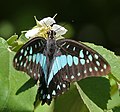Graphium doson
| Common jay | |
|---|---|

| |

| |
| Scientific classification | |
| Domain: | Eukaryota |
| Kingdom: | Animalia |
| Phylum: | Arthropoda |
| Class: | Insecta |
| Order: | Lepidoptera |
| Family: | Papilionidae |
| Genus: | Graphium |
| Species: | G. doson
|
| Binomial name | |
| Graphium doson | |
Graphium doson, the common jay,[1][2] is a black, tropical papilionid (swallowtail) butterfly with pale blue semi-transparent central wing bands that are formed by large spots. There is a marginal series of smaller spots. The underside of wings is brown with markings similar to upperside but whitish in colour. The sexes look alike. The species was first described by father and son entomologists Cajetan and Rudolf Felder.[3][4]
Range
[edit]It is widespread and common throughout Southeast Asia, including lower elevations in Sri Lanka and southern India, Eastern Ghats, Satpuras, Bengal, Assam and Bangladesh, and the Himalayan foothills. The species is however scarce in southern Honshū, Japan.[1][2]
Subspecies
[edit]- G. d. axion (C. & R. Felder, 1864) North India - China, Hainan, Indo-China, Burma, Thailand
- G. d. doson Ceylon
- G. d. eurypylides (Staudinger, 1895) Lombok, Sumbawa
- G. d. evemonides (Honrath, 1884) Peninsular Malaya, Sumatra, Java - Borneo, Philippines
- G. d. gyndes (Fruhstorfer, 1907) Philippines (Palawan, Busuanga, Dumaran)
- G. d. gelap Page and Treadaway, 2011[5]
- G. d. kajanga (Corbet, 1937) Pulau Tioman
- G. d. mikado (Leech, 1887) Japan
- G. d. nauta Tsukada & Nishiyama, 1980 Philippines
- G. d. perillus (Fruhstorfer, 1908)
- G. d. postianus (Fruhstorfer, 1902) Taiwan, Philippines (Batanes)
- G. d. rubroplaga (Rothschild, 1895) Nias
- G. d. robinson Monastyrskii, 2012 South Vietnam, Con Son Island
- G. d. sankapura (Fruhstorfer, 1904) Bawean
Habitat
[edit]It is common in thick, riparian, moist, deciduous, semi-evergreen and evergreen forests.
Behaviour
[edit]The common jay is active throughout the day and constantly on the move; it rarely settles down. Its flight is swift and straight. When feeding from flowers, it never settles down and keeps its wings vibrating. The males are seen mud-puddling, often in tight groups.
Life cycle
[edit]Eggs
[edit]The spherical and pale yellow eggs are laid singly on the underside of leaves.[3]
Larva
[edit]The caterpillar is somewhat spindle shaped. The grown caterpillars have two forms, dark brown or grassy green. There are spines on the fourth segment which are short, conical and blue centred surrounded by lemon yellow and then black rings. The osmeterium is pale bluish green. It is extruded only reluctantly.[3]
Pupa
[edit]The pupa is pale green with a dark purplish median line from the head to the thoracic horn and a yellow line from the tip of the horn to the cremaster.[3]
Images of life cycle
[edit]-
Life cycle
-
Egg
-
Caterpillar
-
Pupa
-
Butterfly
Food plants
[edit]The caterpillars feed on plants of the families Annonaceae, Lauraceae and Magnoliaceae such as Annona lawii, Annona muricata, Cinnamomum macrocarpum, Cinnamomum malabatrum, Magnolia grandiflora, Magnolia liliifera, Magnolia oblonga, Hunteria zeylanica, Michelia champaca, Trachelospermum asiaticum and Polyalthia longifolia.
Gallery
[edit]-
Lateral view of Common Jay butterfly
-
On Singapore cherry (Muntingia calabura) in Hyderabad, India
-
Mud-puddling in Kolkata, West Bengal, India
-
Adult
-
Dead common jay with upper forewing visible
-
Underside of wing from Adalbert Seitz's Macrolepidoptera of the World
-
At Achencovil river
See also
[edit]References
[edit]- ^ a b Varshney, R.K.; Smetacek, Peter (2015). A Synoptic Catalogue of the Butterflies of India. New Delhi: Butterfly Research Centre, Bhimtal & Indinov Publishing, New Delhi. p. 9. doi:10.13140/RG.2.1.3966.2164. ISBN 978-81-929826-4-9.
- ^ a b Savela, Markku. "Graphium doson (C. & R. Felder, 1864)". Lepidoptera and Some Other Life Forms. Retrieved July 2, 2018.
- ^ a b c d
 One or more of the preceding sentences incorporates text from this source, which is in the public domain: Bingham, C.T. (1907). The Fauna of British India, Including Ceylon and Burma. Vol. II (1st ed.). London: Taylor and Francis, Ltd. pp. 106–107.
One or more of the preceding sentences incorporates text from this source, which is in the public domain: Bingham, C.T. (1907). The Fauna of British India, Including Ceylon and Burma. Vol. II (1st ed.). London: Taylor and Francis, Ltd. pp. 106–107.
- ^ Moore, Frederic (1903–1905). Lepidoptera Indica. Vol. VI. London: Lovell Reeve and Co. pp. 1–4.
- ^ Malcolm G. P. Page and Colin G. Treadaway, 2011 New subspecies of Papilionidae from South-east Asia (Lepidoptera: Papilionidae) Nachr. entomol. Ver. Apollo, N.F. 31 (4): 201–205 (2011) pdf
- Evans, W.H. (1932). The Identification of Indian Butterflies (2nd ed.). Mumbai, India: Bombay Natural History Society.
- Kunte, Krushnamegh (2000). Butterflies of Peninsular India. India, A Lifescape. Hyderabad, India: Universities Press. ISBN 978-8173713545.
- Wynter-Blyth, Mark Alexander (1957). Butterflies of the Indian Region. Bombay, India: Bombay Natural History Society. ISBN 978-8170192329.
- Graphium (butterfly)
- Insects of Pakistan
- Butterflies of Malaysia
- Natural monuments of Japan
- Butterflies described in 1864
- Butterflies of Singapore
- Butterflies of Indochina
- Taxa named by Cajetan von Felder
- Taxa named by Rudolf Felder
- Butterflies of Java
- Butterflies of Borneo
- Butterflies of Japan
- Butterflies of Taiwan
- Fauna of Sumatra














